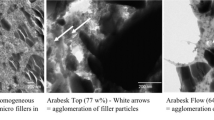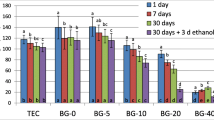Abstract
Objectives
Nanohybrid resin-based composites (RBCs) containing new types of matrix monomers such as dimer acid-based dimethacrylate or tricyclodecane-urethane are assumed to show decreased water uptake and therefore better resistance to hydrolytic degradation than RBCs using bisphenol A diglycidyl methacrylate (BisGMA) due to their hydropobic nature. Our study aimed to analyze the effect of aging on six nanohybrid RBCs, of which two are using these new types of monomers, with regard to differences in the mechanical properties of the materials.
Materials and methods
Diametral tensile strength (DTS), Vickers hardness (HV), and creep were measured. Mechanical tests were performed after storing samples for 24 h in distilled water, as well as after aging (thermocycling for 5,000 cycles at 5–55°C and storage for 4 weeks either in distilled water, artificial saliva, or ethanol).
Results
The effect of aging on all test parameters was lower than the effect of the material. This information was provided by a general linear model, showing higher partial η2 values for the influence factor material than for the factor aging. The influence of aging on the micromechanical properties HV and creep was proven to be more sensitive than on the macromechanical property (DTS). This was also illustrated by lower η2 values for the variable aging for DTS. An increase of the creep of all materials was observed after storage in alcohol.
Conclusions
The use of new types of monomers could not be shown to be a significant advantage to the other examined materials containing BisGMA.
Clinical relevance
Nanohybrid composites can be recommended as universal filling materials, whether based on new or conventional monomers.

Similar content being viewed by others
References
Söderholm KJM, Roberts MJ (1984) Influence of water exposure on the tensile strength of composites. J Dent Res 63:1248–1254
Ferracane JL (2006) Hygroscopic and hydrolytic effects in dental polymer networks. Dent Mater 22:211–222
Deligeorgi V, Mjör IA, Wilson NH (2001) An overview of reasons for the placement and replacement of restorations. Prim Dent Care 8:5–11
Schwartz JI, Söderholm KJ (2004) Effects of filler size, water, and alcohol on hardness and laboratory wear of dental composites. Acta Odontol Scand 62:102–106
Mitra SB, Dong Wu, Holmes B (2003) An application of nanotechnology in advanced dental materials. J Am Dent Assoc 134:1382–1390
Stansbury JW, Bowman N, Trujillo M (2008) Dimer acid-derived dimethacrylates and use in dental restorative compositions. United States Patent Application US 20080318188 assignee: the Regents of the University of Colorado, Boulder, CO, USA
Reiners J, Podszun W, Winkel J (1990) (Meth)acrylic acid derivatives, containing urethane groups, of tricyclo[5.2.1.02.6]decanes. European Patent EP0254185 assignee: BAYER AG
Trujillo-Lemon M, Ge J, Lu H, Tanaka J, Stansbury JW (2006) Dimethacrylate derivates of dimer acid. J Polymer Science Part A 44:3921–3929
Utterodt A et al (2008) Dental composites with Tricyclo[5.2.02.6]decane derivatives. European Patent EP1935393 assignee: Heraeus Kulzer GmbH
Lovell LG, Newman SM, Donaldson MM, Bowman CN (2003) The effect of light intensity on double bond conversion and flexural strength of a model, unfilled resin. Dent Mater 19:458–465
Johnson WW, Dhuru VB, Brantley WA (1993) Composite microfiller content and its effect on fracture toughness and diametral tensile strength. Dent Mater 9:95–98
Deepa CS, Krishnan VK (2000) Effect of resin matrix ratio, storage medium, and time upon the physical properties of a radiopaque dental composite. J Biomater Appl 14:296–315
Aguiar FH, Braceiro AT, Ambrosano GM, Lovadino JR (2005) Hardness and diametral tensile strength of a hybrid composite resin polymerized with different modes and immersed in ethanol or distilled water media. Dent Mater 21:1098–1103
Asmussen E, Peutzfeldt A (1998) Influence of UEDMA BisGMA and TEGDMA on selected mechanical properties of experimental resin composites. Dent Mater 14:51–56
Venz S, Dickens B (1991) NIR-spectroscopic investigation of water sorption characteristics of dental resins and composites. J Biomed Mater Res 25:1231–1248
Ferracane JL (1985) Correlations between hardness and degree of conversion during the setting reaction of unfilled dental restorative resins. Dent Mater 1:11–14
Kim KH, Ong JL, Okuno O (2002) The effect of filler loading and morphology on the mechanical properties of contemporary composites. J Prosthet Dent 87:642–649
Mayworm CD, Camargo SS Jr, Bastian FL (2008) Influence of artificial saliva on abrasive wear and microhardness of dental composites filled with nanoparticles. J Dent 36:703–710
Ilie N, Hickel R (2009) Macro-, micro- and nano-mechanical investigations on silorane and methacrylate-based composites. Dent Mater 25:810–819
Marghalani HY, Al-Jabab AS (2004) Compressive creep and recovery of light-cured packable composite resins. Dent Mater 20:600–610
Söderholm KJ, Mukherjee R, Longmate J (1996) Filler leachability of composites stored in distilled water or artificial saliva. J Dent Res 75:1692–1699
Bettencourt AF, Neves CB, de Almeida MS, Pinheiro LM, Oliveira SA, Lopes LP et al (2010) Biodegradation of acrylic based resins: a review. Dent Mater 26:171–180
Munksgaard EC (2005) Plasticizers in denture soft-lining materials: leaching and biodegradation. Eur J Oral Sci 113:166–169
Larsen IB, Freund M, Munksgaard EC (1992) Change in surface hardness of BisGMA/TEGDMA polymer due to enzymatic action. J Dent Res 71:1851–1853
Larsen IB, Munksgaard EC (1991) Effect of human saliva on surface degradation of composite resins. Scand J Dent Res 99:254–261
Darvell BW (1990) Uniaxial compression tests and the validity of indirect tensile strength. J Mater Sci Mater Med 25:757–780
Lien W, Vandewalle KS (2010) Physical properties of a new silorane-based restorative system. Dent Mater 26:337–344
Utterodt et al. (2010) Compositions for dental composites with tricyclo[5.2.1.02.6]decane derivatives. US Patent 20100076115, 23 March 2010
Conflict of interest
The authors declare that they have no conflict of interest.
Author information
Authors and Affiliations
Corresponding author
Rights and permissions
About this article
Cite this article
Schmidt, C., Ilie, N. The effect of aging on the mechanical properties of nanohybrid composites based on new monomer formulations. Clin Oral Invest 17, 251–257 (2013). https://doi.org/10.1007/s00784-012-0707-3
Received:
Accepted:
Published:
Issue Date:
DOI: https://doi.org/10.1007/s00784-012-0707-3




